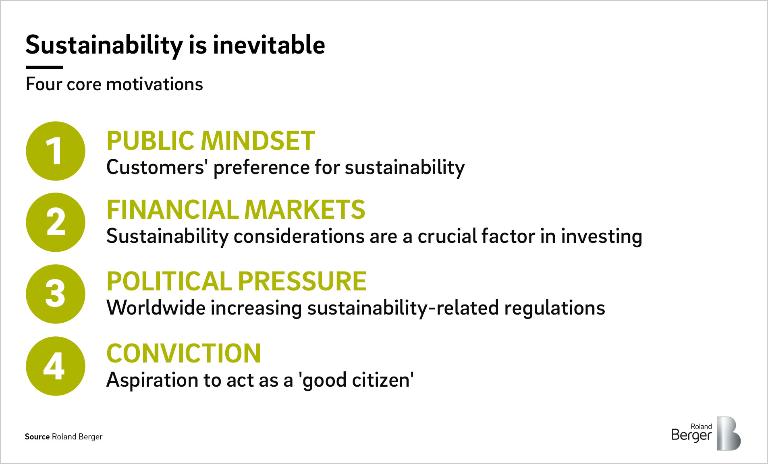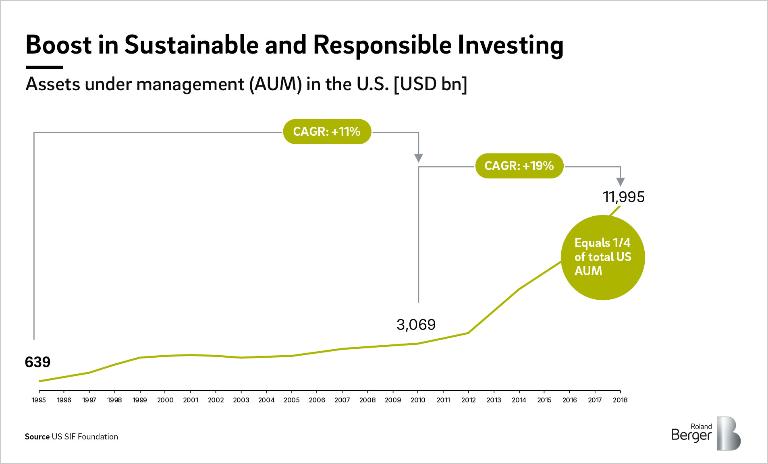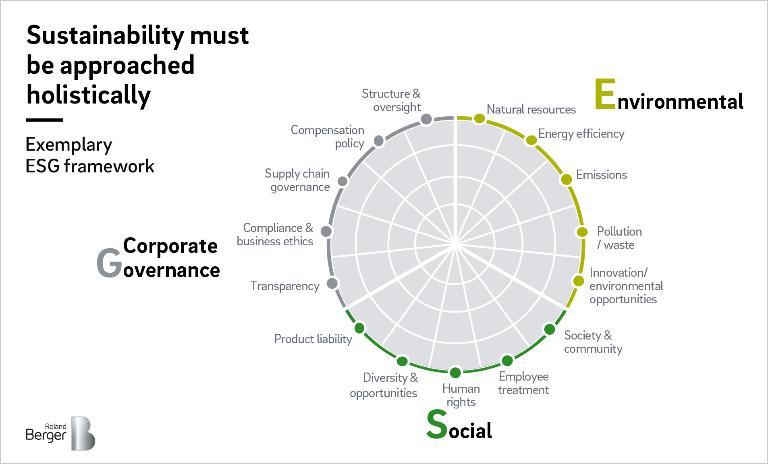

Sustainability – here to stay
By Hannah Zühlke, Christian Böhler and Yvonne Ruf
A framework for a holistic approach to corporate sustainability
"Sustainability is not a 'nice to have' but a prerequisite for future business success. Not realizing the importance of sustainability is a serious liability for any company. "
Achieving carbon neutrality by 2030, and then by 2050, removing from the environment all of the company's carbon emissions since its inception in 1975. This is the bold plan announced by Microsoft in January 2020 as a core pillar of its sustainability strategy. And Microsoft is not alone in its commitment. Many corporations around the globe have issued sustainability goals and they come in all forms from companies of all sizes. For example, Nudie Jeans, a Swedish denim brand, promises free lifelong repairs for every pair of their jeans to decrease resource usage as part of their overall sustainability vision. But where does this focus on sustainability originate? And what will companies' sustainability priorities be?
Motivation for sustainability
In our view there are four main arguments that make it inevitable for sustainability to be high on every company's agenda.
- First, the change in public mindset. Long gone are the days when people focusing on sustainability were, at best, belittled. Be it Fridays for Future or the International Youth Climate Movement, sustainability is a matter of widespread public interest. And especially young people – future customers! – around the globe are becoming more and more vocal in championing it.
- Second, the role of financial markets. A very prominent example of this is the letter from Larry Fink (CEO of Blackrock) to portfolio companies, in which he insistently demands a commitment to sustainability. Many investors feel similarly and incorporate their values in their investment choices. Unsurprisingly, assets under management of funds incorporating sustainability principles have experienced significant growth over the last decade (compound annual growth of 18.6% in 2010-2018 in the US) and there is no end in sight.
- Third, the rise in political pressure and regulation. This can be observed at all levels of government. It starts with local restrictions, such as major cities like Beijing restricting vehicle usage within city boundaries. And it goes on to encompass international actions, such as the European Union's requirement for vehicles sold in the EU to be recycled to a minimum of 85%. Additionally, we noticed an uptick in political support for sustainable companies or startups through dedicated funding or subsidies.
- Lastly, the conviction of doing the right thing. We believe that conviction plays a crucial role in a company's dedication to sustainability. Because in the end, companies are run by people – people that care, people that want to do the right thing and are convinced that sustainability should be at the core of their actions.
Whatever the decisive factor, no company can be under the illusion that sustainability is not important to their business. Incorporating sustainability plays a key role in risk mitigation, especially with regard to regulatory compliance or public exposure of business practices through boycotts or so-called "shitstorms". Additionally, it holds manifold opportunities to open up untapped market potential, improve brand image and recognition and even decrease the cost of borrowing. In short, incorporating sustainability is an imperative in today's business world.
ESG – a holistic approach to sustainability
Sustainability is a broad field that covers much more than just greenhouse gas emissions. Consequently, it must be approached from a holistic perspective. At Roland Berger, we, like many others around the world, define sustainability along three major dimensions: environmental, social and corporate governance aspects – ESG for short.
Environmental aspects include the usage of natural resources, energy efficiency and emissions. Sustainable companies might place value on design-for-recycling, save resources by establishing a circular economy for their products (a.k.a. "cradle-to-cradle" or "closing the loop") or switch to renewable sources of energy.
The French tire manufacturer Michelin, for example, managed to "close the loop" of its tires' lifecycle. In product design, Michelin switched to using micronized rubber powder from recycled tires, thereby replacing oil and rubber-based raw material. Rethinking ownership also played an integral role. By implementing a leasing model based on kilometers run (tracked by RFID chips), Michelin ensures ownership throughout the entire lifecycle. In addition, the company takes end-of-life tires and recovers from them carbon black, an important material for manufacturing new tires.
Another example is the sports car manufacturer Porsche, which realized CO2-neutral production for its first all-electric vehicle. This was achieved through various measures, such as biogas-powered combined heat and power plants as well as electrified logistics vehicles.
The social aspects comprise considerations like safeguarding human rights, fostering diversity and opportunity as well as taking care of product liability. Examples of companies' actions include dedicating resources to development work in regions where components are sourced and promoting an internal climate of inclusion with no regard to gender, ethnicity or age.
Many companies have by now realized the benefits that come with a diverse company culture, such as increased creativity and a greater breadth of opinions and perspectives. Age diversity in particular brings challenges that must be addressed if a company does not want to undermine the potential benefits of such diversity. Potential solutions include buddy programs to foster understanding and exchange between age groups and to promote learning from one another.
Aside from its environmental activities, the Deutsche Post DHL Group, an international logistics company, is a good example of how companies can contribute to the social aspects of sustainability. Through the GoHelp initiative, the group supports disaster management with their logistics know-how, and within GoTeach, employees support partners like Teach For All with their knowledge and commitment. Additionally, every year the group celebrates Global Volunteer Day, during which all employees worldwide are released from work to contribute to society through various volunteering activities.
Finally, the corporate governance aspects include transparency, supply chain governance and compliance. This could involve disclosing ESG measures and results in a publicly available sustainability report, establishing a supplier code of conduct or having a secure whistleblower system.
In addition to taking their own measures, companies can also use their influence and reach to support sustainability by urging others to act. For instance, the investment bank Goldman Sachs announced in early 2020 that it would no longer conduct IPOs for companies without at least one board member who meets diversity criteria – and gave advance notice that it would be demanding at least two in 2021.
Furthermore, technological progress is often a key enabler of sustainable solutions. Through the use of blockchain technology, it is now easier to ensure credible traceability and transparency along the diamond value chain. This assures diamond buyers of ethically legitimate provenance and authenticity – and comes with theft protection built in.
Action plan for companies
Having realized the importance of sustainability, companies need to come up with their own sustainability vision and mission as a first step. The four main arguments elaborated on here are a good starting point for such thoughts. Consideration should also be given to the timeframe.
Armed with a vision and mission, developing a strategy comes next. To shine a light on feasible ESG measures, the company's current situation and its available means should be analyzed thoroughly. A diligent analysis of competitors might yield further inspiration or provide information on potential pitfalls. Furthermore, assessing any upcoming regulations and their impact is crucial at this point.
Once an overarching strategy has been developed, it is helpful to break the strategy down into several pillars. The goal here should be to eventually have action fields that can be pursued and managed independently of each other.
There are various possibilities to shape these fields. One approach could be based on functions (HR, production and supply chain, say). Alternatively, it could be goal oriented (e.g. diversity, supply chain transparency, decarbonization). The best approach varies by company and will depend on the strategy pursued as well as the internal organization and capacities. After establishing the strategic pillars, detailed measures need to be derived. Good measures are relevant, incorporate KPIs, address stakeholders and specify a time horizon.
The next step is to then implement the developed measures. As not all measures can or should be pursued at the same time, proper priorities need to be set – potential factors to consider could be profitability, speed or cost effectiveness. However, we would emphasize the importance of quick wins, easily implementable measures for fast results, as well as lighthouse projects, undertakings with a strong signal effect. Both are tried-and-trusted ways of engaging employees – a crucial success factor in every sustainability strategy in our experience. Additionally, efficient communication, both internally and externally, needs to be ensured.
Act now!
Failing to act on sustainability poses a substantial risk to a company and greatly limits its market potential. The holistic ESG approach is an established framework to guide a company's thoughts. We firmly believe that companies must establish a sustainability strategy in line with their vision and take efficient action now to stay competitive.





_tile_teaser_h260.jpg?v=770441)




